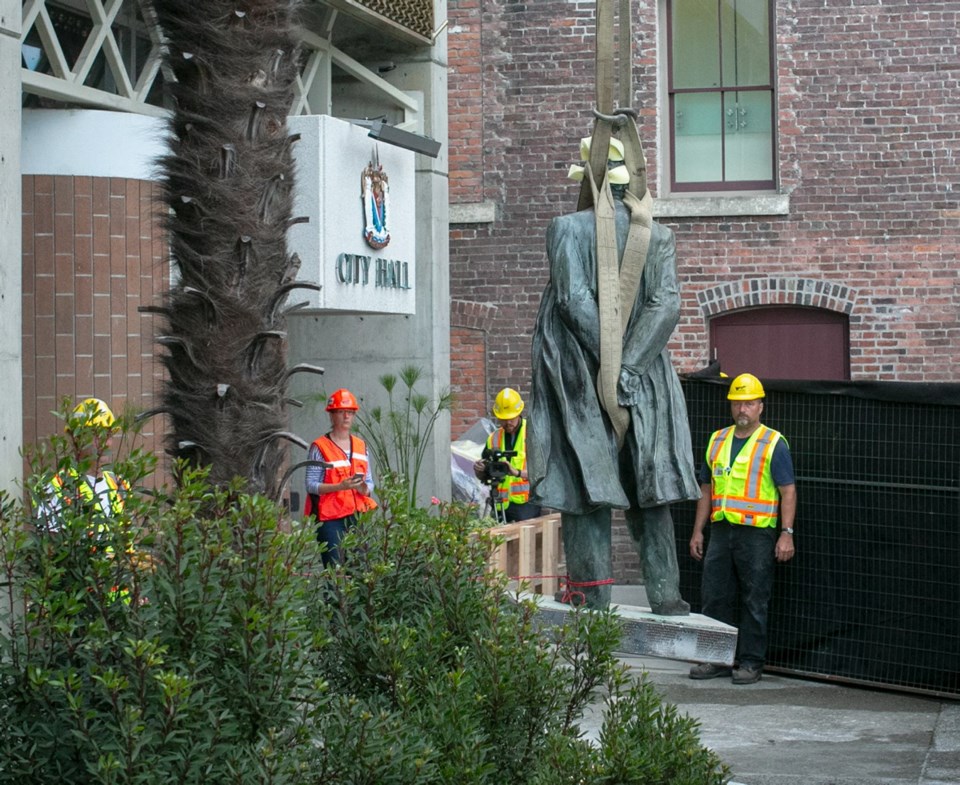The future of the Sir John A. Macdonald statue removed from the steps of Victoria City Hall a year ago won’t be decided until May 2020 at the earliest.
That’s when a city workshop is proposed to be held to “consider the politics of and appropriate context for monuments to controversial historical figures,” including Macdonald. The workshop will be the fifth of a series of six Truth and Reconciliation Dialogues that are recommended to begin this September.
Mayor Lisa Helps said the timing was intentional.
“What happened when we removed the statue of John A. Macdonald was that there was a lot of desire in the community to learn more about reconciliation; to learn more about the Songhees and Esquimalt [First Nations]; to learn more about what it means to build a city on somebody else’s lands and to have a conversation about how do we do reconciliation,” she said.
Helps said the dialogue events are meant to help answer those questions. “It’s really meant to be an educational series,” she said.
The workshops are to be facilitated by Helps and members of the City Family, which included Helps, two councillors, and members of the Indigenous community.
“If my learning over the last two years about reconciliation is any indication, there’s a lot to learn before you dive into a complex conversation about what to do with a statue and how do we balance reconciliation and commemoration more generally,” Helps said.
The planned dialogue events are:
• September 2019 — Elders, knowledge and the land
• November 2019 — The UN Declaration on the Rights of Indigenous People (UNDRIP) and the city
• January 2020 — Newcomers to Canada and reconciliation
• March 2020 — Community response to the Victoria urban reconciliation dialogues event
• May 2020 — Sir John A. Macdonald conversation
• June or July 2020 — Our shared future
A lack of public consultation over the decision to remove the statue last August led to protests and a divisive debate. City council agreed to remove the statue in the interest of reconciliation with First Nations, acting on the recommendation of the City Family.
A sign erected in the statue’s place reads: “In 2017, the City of Victoria began a journey of truth and reconciliation with the Lekwungen peoples, the Songhees and Esquimalt Nations, on whose territories the city stands.”
Meanwhile, Helps has a separate report going to councillors Thursday that attempts to clarify the City Family’s role.
Helps says the City Family “is not, and was never intended to be, an advisory body or a committee of council.”
“It does not conduct city business and does not exercise any delegated authority on behalf of the city,” her report says. “Simply put, it is a unique opportunity for city representatives to meet with representatives of the local Indigenous Peoples to improve understanding and relationships between our communities.”
She makes a number of recommendations designed to clarify the City Family’s status, including:
• Recognition of “the existence of the ‘City Family’ as a gathering of members from the City of Victoria, the Esquimalt Nation, the Songhees Nation and urban Indigenous Peoples;
• Participation of herself, councillors Marianne Alto, Ben Isitt and Charlayne Thornton-Joe, parks director Thomas Soulliere and Colleen Mycroft, manager of executive operations;
• Honoraria of $200 for each meeting of less than four hours and $400 for meetings more than four hours to Indigenous members of the City Family;
• That amendments be made to city bylaws to give council procedural flexibility as part of the reconciliation process;
• And that council write to the province seeking an amendment to the Community Charter to “expressly authorize local governments to engage in reconciliation dialogue with the First Nations and utilize, when appropriate, Indigenous practices as part of that process.”
Helps said there have been many questions about the City Family.
“I thought this was just a very transparent way to say, what it is, what it isn’t, what it does and what it doesn’t,” she said.
“It’s an Indigenous-led, Indigenous-informed approach to basically sit down and talk.”



